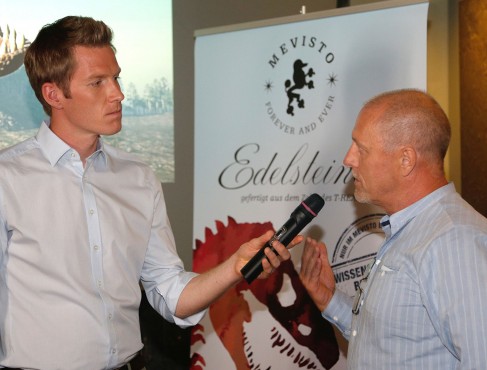The snappiest gemstone in the world!
In cooperation with the Natural History Museum of Vienna, the tooth of a Tyrannosaurus Rex was transformed into a ruby.
Our Managing Director Gerald Reiter himself developed the necessary procedure together with our Head of Development DI Stefan Friedl.
It allows for the production of synthetic gemstones with the ashes or hairs obtained from humans and animals with the help of a chemical process and great heat.

After a tragic event in the family, the topic of "life and death" has held a firm grip on our Managing Director Gerald Reiter from a young age. At that time, he realized that he wanted to find a way to always have his loved ones with him. Through his invention of transforming hair or ashes into colored sapphires or rubies, he has managed to afford mourners a lasting memory of loved ones or departed pets. "It took one and a half years for us and the universities we had teamed up with to develop a process for creating gemstones by means of a chemical process under great heat," explains Daniela Reiter. “Now we have international customers and grow every year. Especially when it comes to funerals, our gemstones can help those affected by offering them an active way to manage their grief.”

The manufacturing process
At least 10 grams of hair or 50 to 100 grams of ashes are needed to produce a synthetic gemstone. The substances obtained from the hair or ashes are homogenized with aluminum oxide and become a gemstone at temperatures above 2,000 degrees.
In contrast to synthetic diamond production, the production of rubies and sapphires does not process carbon, but oxide. Starting from a single crystal, a gemstone is built up layer by layer in which the traces of the individual can be detected chemically. It takes 30 days for a polished gemstone to emerge from hairs or ashes. There is a scientific method that can detect the personal elements in the gemstones.
No one stone is like the other
Contained and detectable in the gemstones of Mevisto are several elements of the respective human being or animal, such as iron, magnesium or calcium. Since these elements occur in different compositions in every living being, the gemstone made from them is just as unique as they are. This is particularly evident in the color composition: Every customer can choose between the shades "ecru", "blue" or "red". However, what the shade ultimately looks like depends on the individual composition of the biogenic material.
For example, an ecru-colored stone may turn out white, champagne, brown or even close to black
Presentation of the world’s “snappiest gemstone”
In celebration of World Biodiversity Day on May 22, we ventured into a new "material" - the tooth of a Tyrannosaurus Rex. Our way of giving a fossil new life in a ruby. "We secured several elements from the tooth of the dinosaur that let us make a synthetic ruby,” explains Daniela Reiter. "The T-Rex stone along with all of our other gemstones are manufactured 100 percent in Austria and subject to strict quality control."
At the press presentation, the 15-carat stone was officially handed over to the Natural History Museum of Vienna. "This unique cooperation gave us an opportunity to resurrect a long-extinct species and transfigure it into an eternal memory with the gemstone," states Dr. Christian Köberl, Director General of the Natural History Museum of Vienna, expressing his joy with the successful cooperation.
The "Dino Stone" can now be viewed during opening hours in the gemstone showcase of the Natural History Museum of Vienna.
